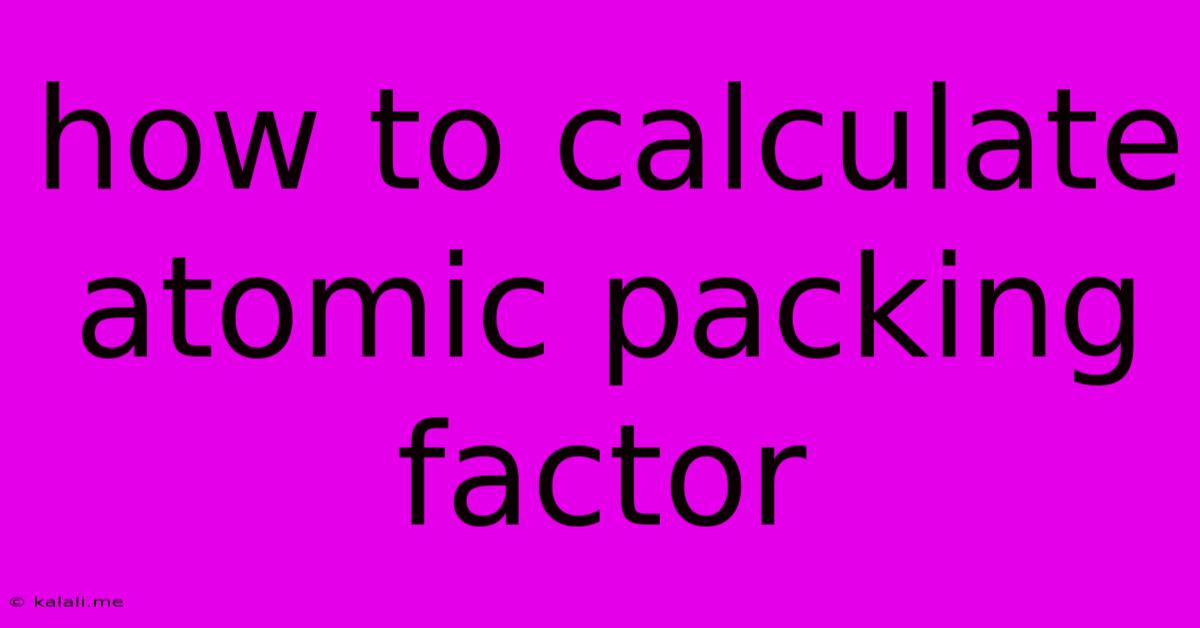How To Calculate Atomic Packing Factor
Kalali
Jun 16, 2025 · 3 min read

Table of Contents
How to Calculate Atomic Packing Factor (APF)
The Atomic Packing Factor (APF) is a crucial concept in materials science, representing the fraction of volume in a crystal structure that is occupied by constituent atoms. Understanding APF helps us predict material properties like density and ductility. This article will guide you through the calculation of APF for different crystal structures. It's a fundamental concept often explored in materials science and engineering courses.
What is Atomic Packing Factor?
The APF is calculated by dividing the total volume of atoms within a unit cell by the volume of the unit cell itself. Essentially, it tells us how efficiently atoms are packed in a given crystal structure. A higher APF indicates a more densely packed structure. This efficiency directly influences a material's properties. For example, materials with high APF tend to be denser and stronger.
Calculating APF: A Step-by-Step Guide
The calculation process varies slightly depending on the crystal structure. Let's look at the common structures:
1. Simple Cubic (SC):
- Volume of atoms: In a simple cubic unit cell, there is only one atom at each corner, and each corner atom is shared by eight unit cells. Therefore, there is effectively only 1/8 * 8 = 1 atom per unit cell. The volume of one atom is (4/3)πr³, where 'r' is the atomic radius.
- Volume of the unit cell: The side length of a simple cubic unit cell is 2r. Therefore, the volume of the unit cell is (2r)³ = 8r³.
- APF Calculation: APF = (Volume of atoms) / (Volume of unit cell) = [(4/3)πr³] / [8r³] = π/6 ≈ 0.524
2. Body-Centered Cubic (BCC):
- Volume of atoms: A BCC unit cell has one atom at each corner (contributing 1 atom) and one atom in the center (contributing 1 atom). This gives a total of 2 atoms per unit cell.
- Volume of the unit cell: The body diagonal of the BCC unit cell is 4r. Using Pythagorean theorem in 3D, we find the relationship between the unit cell edge length (a) and the atomic radius (r): a = (4r) / √3. The unit cell volume is then a³ = (4r/√3)³ = 64r³/(3√3).
- APF Calculation: APF = (2 * (4/3)πr³) / [(64r³)/(3√3)] = π√3/8 ≈ 0.680
3. Face-Centered Cubic (FCC):
- Volume of atoms: An FCC unit cell has atoms at each corner (contributing 1 atom) and atoms at the center of each face (contributing 1/2 * 6 = 3 atoms). This totals 4 atoms per unit cell.
- Volume of the unit cell: The face diagonal of the FCC unit cell is 4r. Using Pythagorean theorem, we find the relationship between the unit cell edge length (a) and the atomic radius (r): a = 2√2r. The unit cell volume is then a³ = (2√2r)³ = 16√2r³.
- APF Calculation: APF = (4 * (4/3)πr³) / [16√2r³] = π√2/6 ≈ 0.740
Significance of APF
The APF values calculated above illustrate that FCC structures have the highest packing efficiency, followed by BCC and then SC. This directly affects material properties such as density, strength, and electrical conductivity. Materials scientists use APF to understand and predict these material properties and select materials appropriately for specific applications. This is why understanding APF calculations is so vital. It is a fundamental building block in many advanced materials science concepts.
Beyond the Basics: Factors Affecting APF
While these calculations provide a good understanding of idealized crystal structures, real-world materials often exhibit imperfections that affect the APF. These imperfections include vacancies, interstitial atoms, and dislocations, all of which can alter the actual packing efficiency.
This detailed guide should provide a solid foundation for understanding and calculating Atomic Packing Factor. Remember that accurate calculations depend on a clear understanding of the specific crystal structure being analyzed.
Latest Posts
Latest Posts
-
How To Create Clickable Image In Html
Jun 16, 2025
-
What Are The Factors Of 121
Jun 16, 2025
-
What Is A Theme Of The Passage
Jun 16, 2025
-
A Company That Provides Access To The Internet
Jun 16, 2025
-
Which Word Is Closest In Meaning To The Underlined Word
Jun 16, 2025
Related Post
Thank you for visiting our website which covers about How To Calculate Atomic Packing Factor . We hope the information provided has been useful to you. Feel free to contact us if you have any questions or need further assistance. See you next time and don't miss to bookmark.